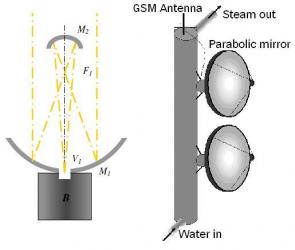
As the scientists explain in a study to be published in the European Journal of Physics, their sunlight trapping system is the optical equivalent of acoustical Dionysius' ear. The design consists of two parabolic mirrors arranged face-to-face. Sunlight first hits the larger mirror and reflects to the smaller mirror placed a short distance away. Then the light from the smaller mirror reflects back, this time being focused into the vertex of the larger mirror. By confining sunlight into this small region, scientists can ideally trap solar radiation. The sunlight is stored in a blackbody, which consists of a cavity with perfectly reflecting inner walls.
"Through a sunlight trap system, solar radiation is first concentrated in a small region of space and then sent into a blackbody, where it can be stored (not for an arbitrary long time, though) for a variety of uses," De Luca told PhysOrg.com. "For example, after having trapped sunlight in a cavity with perfectly reflecting inner walls, what we call a blackbody, one can think of heating water enclosed in a container placed inside the cavity itself. Other uses of this concept are also conceivable."
In their study, De Luca and Fedullo investigated the feasibility of such a perfect sunlight trapping system, which was first envisioned by Paolantonio Zozzaro, a high school physics professor from the Province of Salerno. Zozzaro, who is involved in alternative energy research, wondered what the shape of the smaller mirror should be in order to reflect all incident light rays to the vertex of the larger mirror. Through their calculations, De Luca and Fedullo found that the smaller mirror should have a specific elliptic or hyperbolic profile, similar to Dionysius' ear. They call this secondary mirror a "zozzaroid." They've shown that, theoretically, the design focuses sunlight very effectively, so that it can be transferred to a blackbody with a rather small hole.
The scientists hope that the new sunlight collector could be useful for a variety of alternative energy applications. In a follow-up study, De Luca has investigated the possibility of using the device to generate steam without the need for a convection fluid. In the hollow cavity of the blackbody, he added a metal container into which water is pumped. Through conduction, heat is transferred from the metal container to the water, which is transformed into superheated steam. The steam can then be used for applications such as power generation. In addition to steam generation, such a system might be able to transform sea water into drinking water using only solar energy.
"Let us consider the problem of drinking water on the coasts of hot regions of the globe," De Luca said. "In these places, salt water and sunlight are available in great quantity. Well! It is now not difficult to show that one can use a sunlight trap to heat one side of a metal surface dividing a cylindrical blackbody in two parts. On the other side of the metal surface (which attains a temperature very close to that of the opposite side), one can spray sea water. The generated vapor will then rise in the second chamber of the blackbody and salt will drop down due to gravity. By condensation of the generated vapor, one finally obtains drinkable water."
De Luca and Fedullo predict that constructing a prototype of this system will involve technical challenges due to the highly idealized scheme. However, they hope that a close approximation to the ideal system could lead to many exciting possibilities.
"There can be more applications indeed," De Luca said. "If one can generate overheated steam, one is able to produce electricity, as one does in ordinary thermoelectric power plants. In our case, however, one does not need to burn fossil fuel to generate heat. On the other hand, owing to the periodic availability of sunlight, one has to experiment with new types of controlled power generation systems. This new type of technology may be implemented, on a rather large scale, in a region of the world where the local social and economical development is not yet strictly linked to the availability of fossil fuel and where solar radiation is a rather ample resource.
"A group of developed countries can then make an agreement with the country having such characteristics: We shall invest in testing a model of sustainable industrial development based on alternative energies in your [undeveloped] country, using our technologies and our funds. In return, you will inherit the new developed technology (comprising the possibility of having a public transportation system based on hydrogen vehicles) in the near future, solve some occupational problems and, probably, have a better production of drinking water. Most of all, your country will not contribute to the greenhouse effect, being the first example of a fully developed region whose industrial production and human activity do not emit carbon dioxide into the atmosphere."
R De Luca and A Fedullo. "Focusing light rays back to the vertex of a reflecting parabolic collector: the equivalent of Dionysius ear effect in optical systems." European Journal of Physics. (to be published).



Reader Comments
to our Newsletter